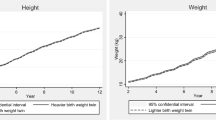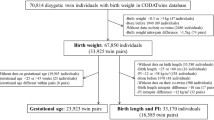Abstract
Objective To determine the effect of very low birth weight (VLBW; <1500 g) and moderately low birth weight (MLBW; 1500–2499 g) on children’s mental and motor development and physical growth during the first 2 years of life and whether VLBW and MLBW babies catch up to normal birth weight (NBW; ≥2500 g) children by age 2. Methods We use data on dizygotic (DZ) and monozygotic (MZ) twins and singleton births from the first two waves of the Early Childhood Longitudinal Study—Birth Cohort (ECLS-B), a nationally representative dataset of children born in the US in 2001. We estimate the effects of VLBW and MLBW on children’s mental and motor development scores, weight-for-age, weight-for-length, weight-for-height, and length-for-age z-scores at 9 months and 2 years. We examine whether differences in outcomes within twin pairs are related to differences in their birth weights. The within-twins analysis is conducted on samples of DZ and MZ twins. For comparison, we also estimate birth weight effects on child outcomes from multivariate linear regression models using the full singleton and twins’ sample. We also estimate the effect of being small-for-gestational age (SGA; birth weight <10th percentile for gestation) using the same set of models in order to separate out the effects of fetal growth restriction from prematurity. Results Evaluation of all births showed that VLBW and MLBW have large negative effects on mental development, motor development, and growth at 9 months and 2 years of age. However, results from within-twin models with DZ twins that control for shared maternal and environmental factors showed much less effect of birth weight on mental or motor development, but continued large effects on growth for the VLBW group. Within-twin models with MZ twins that control for shared maternal, environmental, and genetic factors showed statistically insignificant effects of birth weight on mental and motor development, but continued effects on growth. Similar patterns were found when examining the effects of SGA. Conclusions After controlling for the influence of maternal, environmental, and genetic factors, low birth weight has at most a small negative effect on children’s mental and motor development in their first 2 years of life. However, low birth weight is a major risk factor for children’s physical growth in the early years and there is no evidence of catch-up by age 2.
Similar content being viewed by others
Abbreviations
- BSF-R:
-
Bayley short form—research edition
- CDC:
-
Centers for disease control
- DZ:
-
Dizygotic
- ECLS-B:
-
Early childhood longitudinal study—birth cohort
- IRT:
-
Item response theory
- IUGR:
-
Intrauterine growth restriction
- LBW:
-
Low birth weight
- MLBW:
-
Moderately low birth weight
- MZ:
-
Monozygotic
- NBW:
-
Normal birth weight
- NCES:
-
National center for education statistics
- NCHS:
-
National center for health statistics
- SGA:
-
Small-for-gestational age
- US:
-
United States
- VLBW:
-
Very low birth weight
References
National Center for Health Statistics (NCHS). (2006). Health, United States, 2006 with chartbook on trends in the health of Americans. MD: US Department of Health and Human Services. DHHS 2006-1232.
Barker, D. J. (1995). Fetal origins of coronary heart disease. British Medical Journal, 311, 171–174.
Barker, D. (1998). Mothers, babies and health later in life. Edinburgh: Churchill Livingston.
Barker, D. J. (2001). The malnourished baby and infant. British Medical Bulletin, 60, 69–88. doi:10.1093/bmb/60.1.69.
Aylward, G. P., Pfeiffer, S. I., Wright, A., & Verhulst, S. J. (1989). Outcome studies of low birth weight infants published in the last decade: A meta-analysis. The Journal of Pediatrics, 115, 515–520. doi:10.1016/S0022-3476(89)80273-2.
Brooks, A. M., Byrd, R. S., Weitzman, M., Auinger, P., & McBride, J. T. (2001). Impact of low birth weight on early childhood asthma in the United States. Archives of Pediatrics and Adolescent Medicine, 155(3), 401–406.
Lee, H., & Barratt, M. (1993). Cognitive development of preterm low birth weight children at 5 to 8 years olds. Developmental Behavioral Pediatrics, 14, 242–248.
McCormick, M. C. (1985). The contribution of low birth weight to infant mortality and childhood morbidity. The New England Journal of Medicine, 312, 82–90.
McCormick, M. C., Gortmaker, S. L., & Sobol, A. M. (1990). Very low birth weight children: Behavior problems and school difficulty in a national sample. The Journal of Pediatrics, 117, 687–693. doi:10.1016/S0022-3476(05)83322-0.
Paneth, N. S. (1995). The problem of low birth weight. The Future of Children, 5(1), 19–34. doi:10.2307/1602505.
Richards, M., Hardy, R. J., Kuh, D., & Wadsworth, M. E. J. (2001). Birth weight and cognitive function in the British 1946 birth cohort: Longitudinal population based study. British Medical Journal, 322, 199–203. doi:10.1136/bmj.322.7280.199.
Wu, Y. W., Croen, L. A., Shah, S. J., Newman, T. B., & Najjar, D. V. (2006). Cerebral palsy in a term population: Risk factors and neuroimaging findings. Pediatrics, 118, 690–697. doi:10.1542/peds.2006-0278.
Korhonen, P., Tammela, O., Koivisto, A. M., Laippala, P., & Ikonen, S. (1999). Frequency and risk factors in bronchopulmonary dysplasia in a cohort of very low birth weight infants. Early Human Development, 54(3), 245–258. doi:10.1016/S0378-3782(98)00101-7.
Hack, M., Taylor, H. G., Drotar, D., Schluchter, M., Cartar, L., Andreias, L., et al. (2005). Chronic conditions, functional limitations, and special health care needs of school-aged children born with extremely low-birth-weight in the 1990s. Journal of the American Medical Association, 294, 318–325. doi:10.1001/jama.294.3.318.
Iliadou, A., Cnattingius, S., & Lichtenstein, P. (2004). Low birthweight and type 2 diabetes: A study on 11, 162 Swedish twins. International Journal of Epidemiology, 33, 948–953. doi:10.1093/ije/dyh117.
Hubinette, A., Cnattingius, S., Ekbom, A., de Faire, U., Kramer, M., & Lichtenstein, P. (2001). Birthweight, early environment, and genetics: A study of twins discordant for acute myocardial infarction. Lancet, 357, 1997–2001. doi:10.1016/S0140-6736(00)05111-4.
Hubinette, A., Cnattingius, S., Johansson, A. L., Henriksson, C., & Lichtenstein, P. (2003). Birth weight and risk of angina pectoris: Analysis in Swedish twins. European Journal of Epidemiology, 18, 539–544. doi:10.1023/A:1024686625528.
Babson, S. C., Kangas, J., Young, N., & Bramhall, J. L. (1964). Growth and development of twins of dissimilar size at birth. Pediatrics, 33, 327.
Churchill, J. A. (1965). The relationship between intelligence and birth weight in twins. Neurology, 4, 341.
Scarr, S. (1969). Effects of birthweight on later intelligence. Social Biology, 16, 249.
Willerman, L., & Churchill, J. A. (1967). Intelligence and birth weight in identical twins. Child Development, 38, 623. doi:10.2307/1127240.
Newcombe, R., Milne, B. J., Caspi, A., Poulton, R., & Moffitt, T. E. (2007). Birthweight predicts IQ: Fact or artefact? Twin Research and Human Genetics, 10(4), 581–586. doi:10.1375/twin.10.4.581.
Stein, R. E. K., Seigel, M. J., & Bauman, L. J. (2006). Are children of moderately low birth weight at increased risk for poor health? A new look at an old question. Pediatrics, 118, 217–223. doi:10.1542/peds.2005-2836.
National Center for Education Statistics (NCES). (2004). Early childhood longitudinal study, birth cohort (ECLS-B). User’s manual for the ECLS-B nine month restricted-use data file and electronic codebook. MD: US Department of Education. Institute of Education Sciences. NCES 2004-092.
National Center for Education Statistics. (2006). Early Childhood longitudinal study, birth cohort (ECLS-B). User’s manual for the ECLS-B longitudinal 9-month–2-year data file and electronic codebook. MD: US Department of Education. Institute of Education Sciences. NCES 2006–046.
Goldsmith, H. H. (1991). A zygosity questionnaire for young twins: A research note. Behavior Genetics, 21, 257–269. doi:10.1007/BF01065819.
Nichols, R. C., & Bilbro, W. C. (1966). The diagnosis of twin zygosity. Acta Genetica et Statistica Medica, 16, 265–275.
Cohen, D. J., Dibble, E., Grawe, J. M., & Pollin, W. (1975). Reliably separating identical from fraternal twins. Archives of General Psychiatry, 32, 1371–1375.
Alexander, G. H., Himes, J. H., Kaufman, R. B., Mor, J., & Kogan, M. (1996). A United States national reference for fetal growth. Obstetrics and Gynecology, 87(2), 163–168. doi:10.1016/0029-7844(95)00386-X.
Resnick, R. (2002). Intrauterine growth restriction. Obstetrics and Gynecology, 99(3), 490–496. doi:10.1016/S0029-7844(01)01780-X.
Bayley, N., & Bayley Scales of Infant Development. (1993). The psychological corporation (2nd ed. Manual). TX: San Antonio.
Hambleton, R. K., Swaminathan, H., & Rogers, H. J. (2000). Fundamentals of item response theory. Newbury Park, CA: Sage Press.
Kotelchuck, M. (1994). The adequacy of prenatal care utilization index: Its US distribution and association with low birthweight. American Journal of Public Health, 84(9), 1486–1489.
Carlin, J. B., Gurrin, L. C., Sterne, J. A. C., Morley, R., & Dwyer, T. (2005). Regression models for twin studies: A critical review. International Journal of Epidemiology, 34, 1089–1099. doi:10.1093/ije/dyi153.
Baird, J., Osmond, C., MacGregor, A., Snieder, H., Hales, C. N., & Phillips, D. I. (2001). Testing the fetal origins hypothesis in twins: The Birmingham twin study. Diabetologia, 44, 33–39. doi:10.1007/s001250051577.
Christensen, K., Stovring, H., & McGue, M. (2001). Do genetic factors contribute to the association between birth weight and blood pressure? Journal of Epidemiology and Community Health, 55, 583–587. doi:10.1136/jech.55.8.583.
Dwyer, T., Blizzard, L., Morley, R., & Ponsonby, A. L. (1999). Within pair association between birth weight and blood pressure at age 8 in twins from a cohort study. British Medical Journal, 319, 1325–1329.
Ijzerman, R., Stehouwer, C. D., & Boomsma, D. I. (2000). Evidence for genetic factors explaining the birth weight-blood pressure relation. Analysis in twins. Hypertension, 36, 1008–1012.
Johansson-Kark, M., Rasmussen, F., De Stavola, B., & Leon, D. A. (2002). Fetal growth and systolic blood pressure in young adulthood: The Swedish young male twins study. Paediatric and Perinatal Epidemiology, 16, 200–209. doi:10.1046/j.1365-3016.2002.00424.x.
Loos, R. J., Fagard, R., Beunen, G., Derom, C., & Vlietinck, R. (2001). Birth weight and blood pressure in young adults: A prospective twin study. Circulation, 104, 1633–1638. doi:10.1161/hc3901.096699.
Nowson, C. A., MacInnis, R. J., Hopper, J. L., et al. (2001). Association of birth weight and current body size to blood pressure in female twins. Twin Research, 4, 378–384. doi:10.1375/1369052012551.
Poulter, N. R., Chang, C. L., MacGregor, A. J., Snieder, H., & Spector, T. D. (1999). Association between birth weight and adult blood pressure in twins: Historical cohort study. British Medical Journal, 319, 1330–1333.
Zhang, J., Brenner, R. A., & Klebanoff, M. A. (2001). Differences in birth weight and blood pressure at age 7 years among twins. American Journal of Epidemiology, 153, 779–782. doi:10.1093/aje/153.8.779.
Ford, G. W., Doyle, L. W., Davis, N. M., & Callanan, C. (2000). Very low birth weight and growth into adolescence. Archives of Pediatrics and Adolescent Medicine, 154(8), 778–784.
Hack, M., Schluchter, M., Cartar, L., Rahman, M., Cuttler, L., & Borawski, E. (2003). Growth of very low birth weight infants to age 20 years. Pediatrics, 112(1 Pt 1), e30–e38. doi:10.1542/peds.112.1.e30.
Evensen, K. A., Vik, T., Helbostad, J., Indredavik, M. S., Kulseng, S., & Brubakk, A. M. (2004). Motor skills in adolescents with low birth weight. Archives of Disease in Childhood. Fetal and Neonatal Edition, 89(5), F451–F455. doi:10.1136/adc.2003.037788.
Whitaker, A. H., Feldman, J. F., Lorenz, J. M., Shen, S., McNicholas, F., Nieto, M., et al. (2006). Motor and cognitive outcomes in nondisabled low-birth-weight adolescents: Early determinants. Archives of Pediatrics and Adolescent Medicine, 160(10), 1040–1046. doi:10.1001/archpedi.160.10.1040.
Martinez-Cruz, C. F., Poblano, A., Fernandez-Carrocera, L. A., Jimenez-Quiroz, R., & Tuyu-Torres, N. (2006). Association between intelligence quotient scores and extremely low birth weight in school-age children. Archives of Medical Research, 37(5), 639–645. doi:10.1016/j.arcmed.2005.12.001.
Hall, J. G. (2003). Twinning. Lancet, 362(9385), 735–743. doi:10.1016/S0140-6736(03)14237-7.
Hall, J. G. (1996). Twinning: Mechanisms and genetic implications. Current Opinion in Genetics and Development, 6(3), 343–347. doi:10.1016/S0959-437X(96)80012-8.
Martin, J.A., Hamilton, B.E., Sutton, P.D., et al. (2006). Births: Final data for 2004. National vital statistics reports (vols. 55 no 1). Hyattsville, MD: National Center for Health Statistics.
Acknowledgments
The authors thank Dr. Homero Martinez, Dr. Jennifer Park, three anonymous referees, and participants at the Early Childhood Longitudinal Study—Birth Cohort (ECLS-B) First Release Conference: Development from Birth through Age Two for helpful comments. This research was funded by a National Institute for Child Health and Human Development grant (R03HD051578). All opinions expressed are those of the authors and not of the funding agency.
Author information
Authors and Affiliations
Corresponding author
Appendix
Appendix
See Table 6
Rights and permissions
About this article
Cite this article
Datar, A., Jacknowitz, A. Birth Weight Effects on Children’s Mental, Motor, and Physical Development: Evidence from Twins Data. Matern Child Health J 13, 780–794 (2009). https://doi.org/10.1007/s10995-009-0461-6
Received:
Accepted:
Published:
Issue Date:
DOI: https://doi.org/10.1007/s10995-009-0461-6




